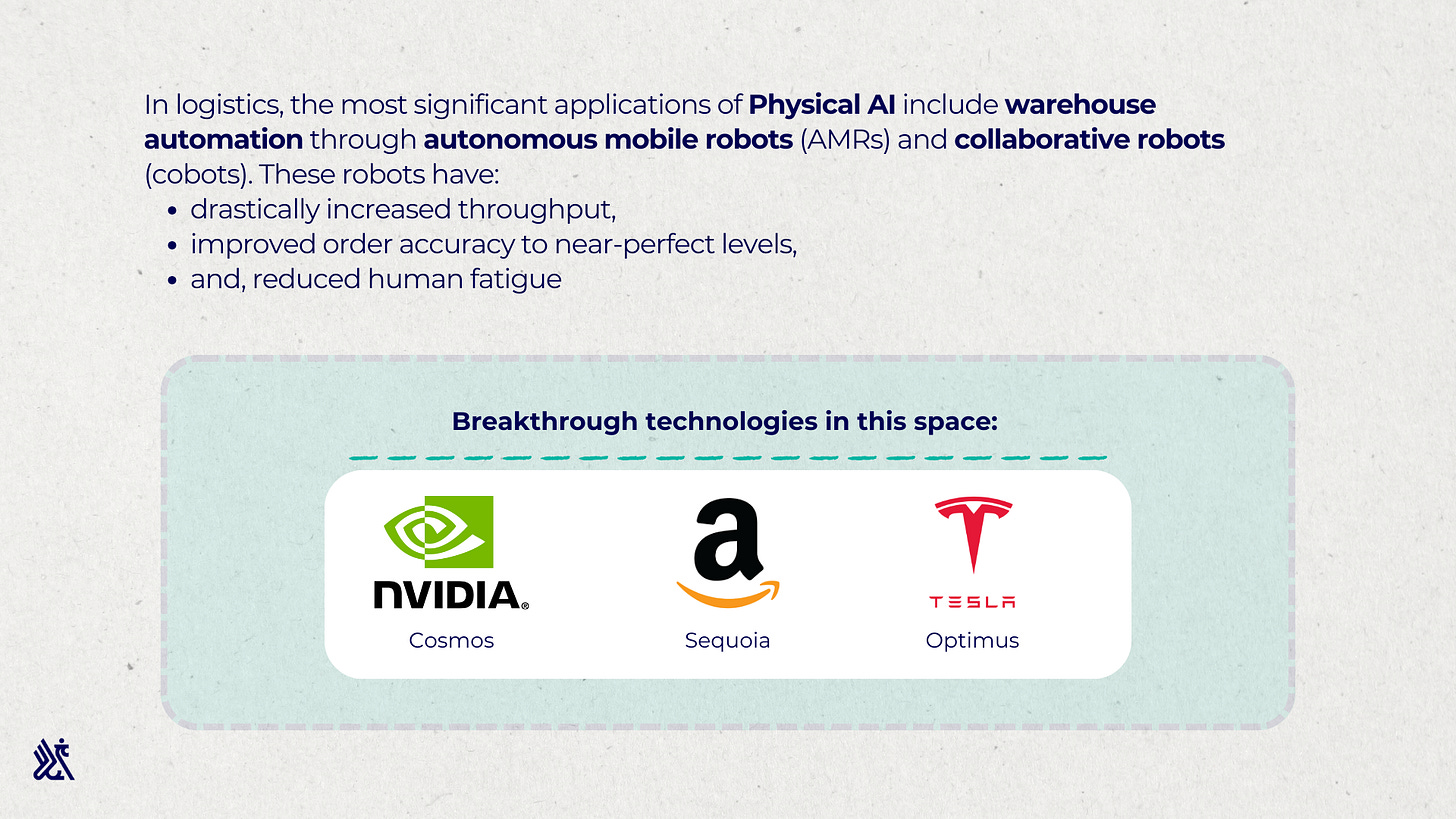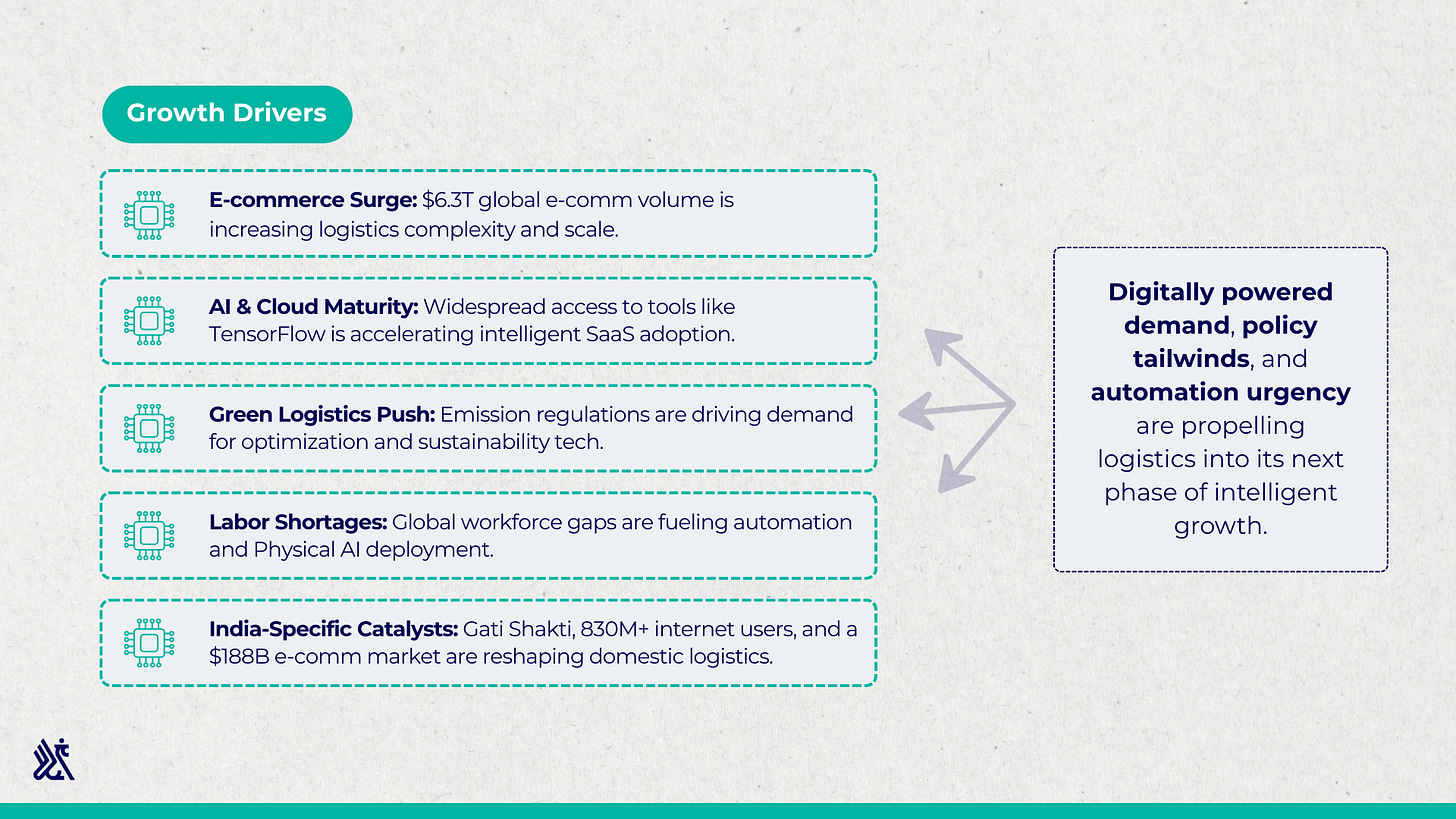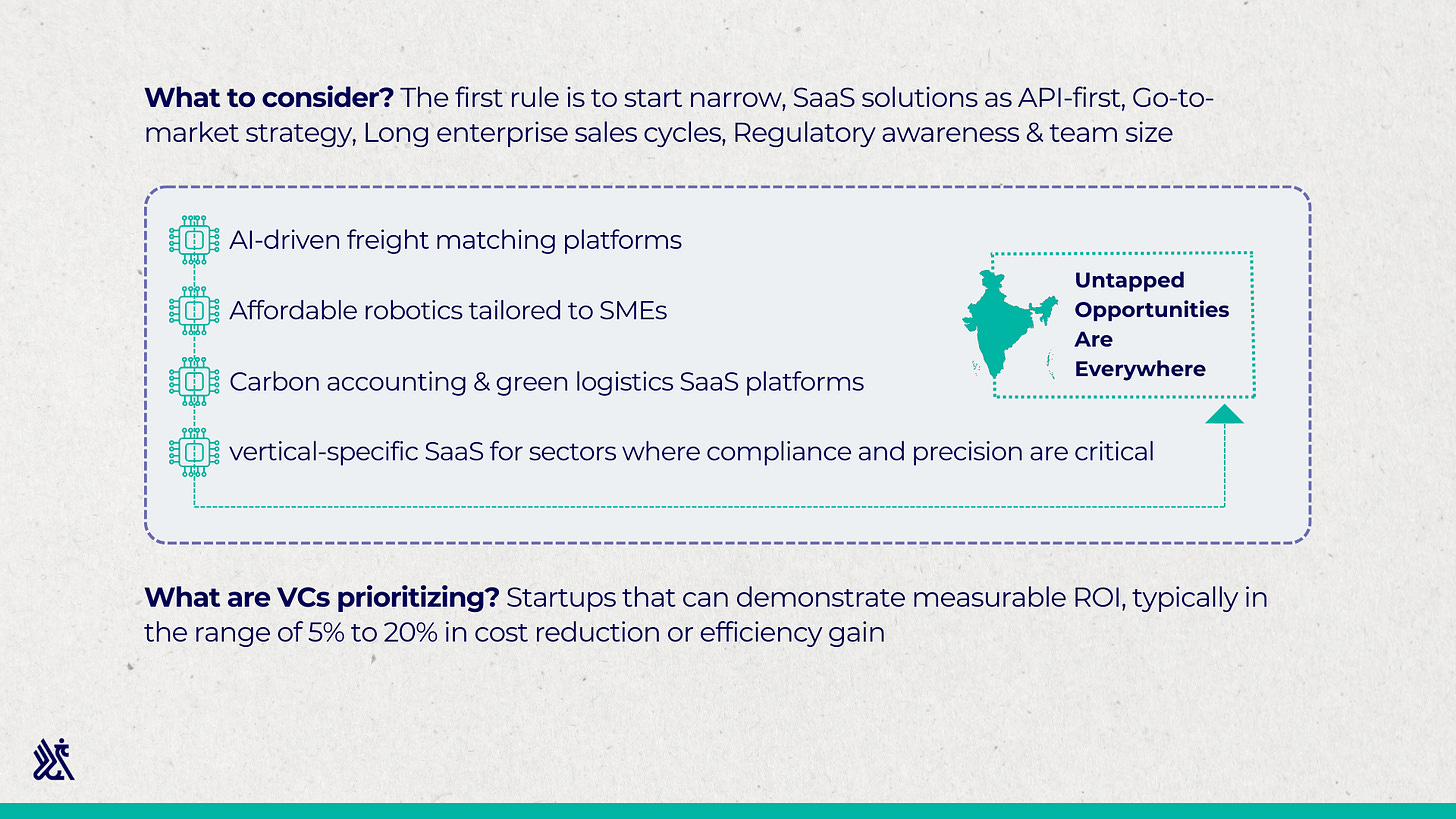Beyond Automation: The Smart Supply Chain Era Is Here
The tech is ready. The market is massive. But in smart logistics, precision, interoperability, and ROI will separate the hype from the real disruptors.
Hi there!
This week on Eximius Echo, we’re shifting gears into a sector that’s long been the backbone of commerce, but is now becoming its brain. Logistics is undergoing a once-in-a-generation tech transformation, moving beyond automation into the era of intelligent, self-optimizing supply chains.
With global logistics projected to hit $23.1T by 2034 and India’s market set to triple, the stakes, and the opportunities - have never been higher. At the heart of this shift? A new breed of SaaS platforms and Physical AI solutions that are redefining how goods move, decisions are made, and value is unlocked.
In this edition, we unpack the rise of smart logistics, from cloud-first platforms to autonomous robots, explore the whitespace for vertical SaaS, and spotlight the startups (and investors) racing to build the digital operating system for global trade.
If you’re new here, Eximius is a pre-seed VC fund backing bold ideas in Fintech, AI/SaaS, and Consumer Tech. We use this newsletter to share insights, trends, and ideas from the sectors we’re passionate about. Let’s dive in.
Defining the Market: Logistics and the Rise of SaaS
The logistics industry is the critical backbone of global commerce, managing the end-to-end movement of goods, services, and data from origin to consumption. As of 2025, the global logistics market stands at $11.2 Tn and is expected to nearly double to $23.1 Tn by 2034, driven by the explosion in e-commerce, global trade, and the rapid digitization of supply chains. India’s logistics industry, currently valued at approximately $254 Bn, is on an ambitious trajectory to reach close to $803 Bn by 2034, powered by infrastructure investments, national policy initiatives, and a growing digital ecosystem.
Within this vast industry, Logistics SaaS, a cloud-based software that digitizes and optimizes logistics operations, is emerging as a key value lever. Globally, the Logistics SaaS market is pegged at $24.2 Bn in 2025 and expected to exceed $56 Bn by 2033, while India’s market, currently $1.6 Bn, is poised to reach $10 Bn by 2035 (~10x growth).
What is Physical AI, and Why It Matters for Logistics
According to NVIDIA, Physical AI is the fusion of artificial intelligence with physical systems capable of perceiving, reasoning, and acting in dynamic environments. This includes technologies like robotics, autonomous vehicles, and edge AI platforms trained using generative models and digital twins.
In logistics, the most significant applications of Physical AI include warehouse automation through autonomous mobile robots (AMRs) and collaborative robots (cobots). These robots have:
drastically increased throughput,
improved order accuracy to near-perfect levels,
and, reduced human fatigue.
Autonomous Mobile Robots (AMRs), using LiDAR + onboard AI, are gaining traction in warehousing. Moreover, IoT is enabling real-time data visibility for temperature, movement, and location. Additionally, autonomous trucks and drones are redefining freight and last-mile delivery with greater reliability and reduced operational costs. Innovations like exoskeletons are enhancing worker safety and endurance, while swarm robots are orchestrating collective tasks in large fulfillment centers.
Where We Are in 2025: Tech Adoption and Industry State
By 2025, logistics is no longer viewed as a cost center; it has become a strategic function. Global warehouse robotics adoption is surging, with around half of the world’s large warehouses now deploying some form of robotic automation, from automated picking to sorting systems.
Global Legacy players are shaping the Logistics SaaS landscape through innovation and intelligent AI solutions:
Project44 and FourKites are pioneering real-time shipment visibility, enabling businesses to track goods across the globe with unparalleled accuracy and responsiveness.
Flexport, with its digital freight forwarding platform, empowers companies with advanced analytics to streamline global trade operations.
Enterprise software giants like Oracle Cloud TMS and Kinaxis are offering scalable orchestration platforms for large supply chains, integrating AI to deliver robust demand planning and inventory management.
In India, logistics SaaS is undergoing a parallel revolution:
Locus and LogiNext are leveraging AI to optimize routes and enhance last-mile delivery precision.
FarEye and Shipsy are addressing cross-border logistics complexities with unified, multi-carrier platforms that digitize documentation and customs.
CargoFL is building a niche by providing AI-driven decision support tools tailored for India’s small and medium logistics players.
Across the board, solutions span Transportation Management Systems (TMS), Warehouse Management Systems (WMS), Fleet Management Solutions (FMS), and Real-Time Visibility Platforms, forming a new digital operating system for logistics.
Technologies like predictive analytics are now standard, allowing companies to forecast demand and optimize resources more accurately than ever before.
AI-powered route optimization is reducing fuel costs and delivery times, while AMRs are accelerating warehouse workflows.
Real-time visibility platforms are enabling resilient, transparent, and responsive supply chains. Companies such as Amazon and Uber Freight report significant gains, including 15x improvements in demand forecasting and up to 15% reductions in empty miles.
Key Growth Drivers for Logistics and SaaS
The global logistics and SaaS sectors are thriving, fueled by transformative macro and micro drivers. Worldwide, the growth of e-commerce, now accounting for $6.3 Tn in annual sales, has dramatically increased the volume and complexity of logistics operations. The maturation of cloud infrastructure and the accessibility of AI tools like TensorFlow has enabled widespread adoption of intelligent logistics platforms. Environmental regulations are pushing companies toward green logistics, creating demand for optimization tools that reduce emissions. Meanwhile, widespread labor shortages are accelerating automation as companies seek alternatives to manual labor.
India has its own set of potent drivers. National policies like the National Logistics Policy and the PM Gati Shakti Master Plan are channeling billions into logistics infrastructure.
Digital penetration is rising, with over 830 million internet users and 97% wireless reach, enabling SaaS accessibility even in rural and Tier 2/3 cities. The Indian e-commerce market is projected to reach $188 Bn by 2025, acting as a core catalyst for logistics demand.
Challenges and White Space Opportunities
Despite significant progress, logistics remains fraught with inefficiencies and systemic gaps:
Globally, 30% of truck trips still run empty, contributing to fuel waste and emissions.
Last-mile delivery remains disproportionately expensive, comprising over half of total shipping costs.
Visibility remains fragmented,
and most companies lack true end-to-end insight into their supply chains.
In India, logistics costs remain stubbornly high at around 16% of GDP, compared to 8% in developed economies. Most logistics players still operate outside the formal economy, which limits their ability to scale and adopt technology. Infrastructure bottlenecks, regulatory complexity, and inconsistent service quality exacerbate the problem.
These challenges create enormous whitespace opportunities:
AI-driven freight matching platforms can dramatically reduce empty miles by optimizing load utilization.
Affordable robotics tailored to SMEs can bring automation to underserved markets, especially in Tier-2 and Tier-3 cities.
Carbon accounting and green logistics SaaS platforms are emerging to help companies meet sustainability goals.
There is also untapped potential in building vertical-specific SaaS for sectors like pharmaceuticals, cold chains, and hazardous materials logistics, where compliance and precision are critical.
Physical AI solutions can transform outcomes, reduce costs, and improve efficiency all across.
What to Consider Before Building
For founders eyeing this sector, building a logistics or SaaS startup in 2025 requires more than just technical execution. The first rule is to start narrow, to essentially solve one acute problem deeply rather than spreading thin. The logistics sector values proven ROI, so your product must clearly drive cost savings or revenue uplift. Architecting the SaaS solutions as API-first ensures it can integrate into diverse tech stacks across clients.
Go-to-market strategy is equally critical. Partnering with 3PLs, e-commerce platforms, or even regulatory bodies can accelerate adoption. Founders must also be prepared for long enterprise sales cycles, especially in logistics-heavy verticals like retail, pharma, or manufacturing. Regulatory awareness is essential, particularly for Physical AI applications involving drones, autonomous vehicles, or international shipping. Understanding compliance, customs, and safety protocols can make or break adoption. Lastly, team size is shaping up to be a significant factor, wherein larger teams to manage heavy operations would be the norm.
VC Investment Trends and Future Outlook
Venture capital activity in logistics is rebounding with a sharp focus on:
Applied AI
Autonomous freight corridors
Micro-fulfillment centers
Drone tech
In Q1 2025, AI-focused startups attracted $59.6 Bn globally, with logistics regaining its appeal as a sector ripe for intelligent transformation, with an emphasis towards capital-efficient models solving real operational inefficiencies.
VCs are prioritizing startups that can demonstrate measurable ROI, typically in the range of 5% to 20% in cost reduction or efficiency gain. Proprietary data and scalable, cloud-native architecture are key factors in investment decisions. VCs are also looking for solutions that address urgent problems and offer plug-and-play integrations, particularly for global markets.
Conclusion: The Smart Supply Chain is Here
The convergence of Logistics SaaS, AI, and Physical AI is fundamentally reshaping global supply chains.
SaaS is bringing integration and automation
AI is enabling predictive intelligence and strategic decision-making
Physical AI is powering scalable, machine-led execution
India’s unique mix of policy tailwinds, tech talent, and startup energy positions it as a global test-bed for logistics innovation.
The message is clear:
Invest now in intelligent logistics, or get left behind.
By 2030, the smart supply chain won’t be a differentiator, it’ll be the default.
If you are looking to build in this space, we would love to chat! Please reach out to us at pitches@eximiusvc.com.








